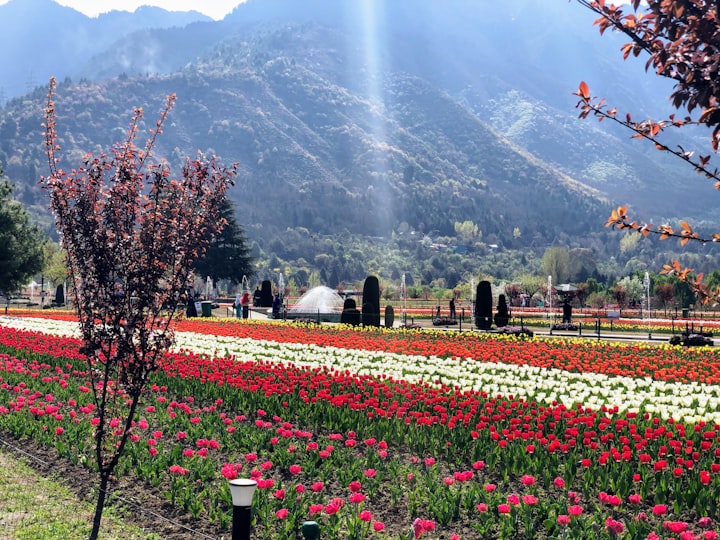Discover the tulip garden in the Netherlands.
Growing a Beautiful Tulip Garden: Tips and Techniques
Is a visit to Keukenhof and the Tulip Barn in the Netherlands during spring worth the hype?
Spring is a captivating and unpredictable season, especially here in the Netherlands, known for its tulips. The famous flowers draw countless visitors annually, with social media playing a significant role in their popularity. Bollenstreek, a bulb-growing region just a short distance from Amsterdam, is among the top destinations during spring. One of the key attractions is Keukenhof, a renowned tulip hub that charges a 19-euro entrance fee.The admission fee is 19 euros. The aroma here is remarkable. This is the largest tulip garden in the Netherlands, boasting over 7 million tulips, along with daffodils, hyacinths, and other bulb flowers, all meticulously planted by hand. Patrick van Dijk is anticipating my arrival; he has been part of the Keukenhof team since 2019. The office here is truly exceptional, arguably the best in the world. Typically, tulips bloom for 2 weeks, but a fascinating technique is employed here. Known as lasagna planting, this method extends the blooming period to 6 weeks. The late bloomers are at the bottom, the mid-bloomers in the middle, and the early bloomers at the top. Each segment blooms consecutively for 2 weeks. Keukenhof has a rich history, commencing in 1949 with just a handful of gardeners.Keukenhof has a lengthy history that began in 1949 with only a handful of gardeners. Nowadays, numerous exhibitors showcase their finest flowers at the park, which opens annually from March to May. Beyond the initial planting, the notable challenge lies in maintaining the expansive 32-hectare garden. This task involves various aspects such as keeping the grass trimmed to a specific height by mowing it weekly. Additionally, post-season challenges include ensuring the park remains adequately watered and the trees thrive, all without the aid of an irrigation system. The park's reliance on manual watering makes rainfall a welcome break for the gardeners. In 2022, over 1 million visitors flocked to Keukenhof, leading to significant overcrowding. Insiders recommend steering clear of main paths and avoiding weekend visits to dodge the crowds. Despite tulips originating from Asia, they have been cultivated in the Netherlands for centuries. The nation's status as a leading tulip producer is attributed to its ideal weather conditions and soil quality for tulip cultivation.The soil is sandy and well-hydrated, essential for the optimal growth of tulip bulbs. Centuries ago, a single tulip bulb was priced as high as a luxurious house in the Netherlands. The tulip became highly sought after as a symbol of wealth, status, and rarity, causing its value to skyrocket. During the peak of the Tulipmania period, a single tulip bulb could fetch up to 2,000 euros. Today, the same tulip bulb costs mere cents. The Tulip Barn, established in 2021 by Lian Ruigrok and her daughter Romy Ruigrok, offers a less crowded but equally picturesque alternative for tulip enthusiasts. With over 500,000 tulips and 175 different varieties, visitors can explore the fields and even take selfies amidst the vibrant blooms. The entrance fee is 7.50 euros, providing a unique and Instagram-worthy experience. This innovative concept was born out of a campaign to educate tourists about the distinction between tulip fields for production and those for public enjoyment.At a tulip field, the focus is on tulip production rather than photography. To provide a photo-friendly alternative, we adjusted the paths to allow for easy access without causing damage to the flowers. The wider paths enable visitors to stroll through while keeping most of the tulips intact, showcasing a stunning array of colors. Additionally, the spacious layout allows for a more enjoyable and less crowded experience. If you enjoy taking selfies, this location is ideal. Cultivating a garden to bloom throughout the season relies on both nature and weather conditions. To ensure continuous blooming, we pre-cool a portion of the tulip bulbs before planting. This process tricks the tulips into perceiving a longer winter, prompting them to bloom earlier than usual.The process involves manipulating nature to ensure continuous blooming throughout the season. Weather poses the main challenge, especially after experiencing unexpected snowfall in April last year, negatively affecting our tulips. Fortunately, this summer is expected to be favorable. However, we faced another issue this year when ducks started to consume our bulbs, resulting in some areas with a meter of tulips failing to bloom. Despite these setbacks, the vibrant spring scenery in the Netherlands makes it a memorable experience worth revisiting.
2 billion tulip bulbs: Methods for cultivating tulips in a reenhouse
The Dutch have cultivated tulips since the 17th century, making them the world's largest tulip bulb exporter. In 2020, around 27,000 hectares of Dutch agricultural land were dedicated to flower bulb cultivation, with over half of that area reserved for tulips, totaling approximately 2 billion bulbs. 90% of these tulip bulbs are exported. Tulips are globally popular for their vibrant colors and unique cultivation methods. This video demonstrates the planting, growth, and harvesting of tulips, along with a challenge: why are tulip bulbs planted twice a year? Stay tuned for the answer. Explore the secrets of tulip beauty, starting with the autumn planting process in October and November.The flowers bloom in early spring, typically from January to April. Bulbs are planted around 15 cm deep to protect them from frost and are spaced 10 to 20 cm apart. Large farms usually cultivate their own bulbs, a topic we will delve into further in this video. These bulbs are placed in nets during planting to facilitate their removal from the soil later on. The process will be clearly demonstrated during harvest time. At this moment, let's observe the satisfying procedure. Once tulips sprout, they are meticulously checked for viruses or diseases, with any unhealthy plants promptly eliminated to make room for the healthy ones. After approximately four months, the tulips are in full bloom, drawing tourists from around the globe. Despite their appeal to tourists, these tulips are primarily grown for cultivation as bulbs or to produce new ones.To ensure the energy is directed to the bulbs rather than the flowers, the tulips are topped by cutting off their heads. This process is done using a machine to avoid harming the leaves. However, smaller tulips require manual topping. The cut flowers are left on the ground to serve as natural fertilizer. You've learned about topping, caring for, and planting tulips. Next, we will delve into their cultivation in greenhouses. But for now, it's time for harvest, which typically occurs between mid-June and late July. The tulip bulb is now fully developed and sufficiently large, having produced numerous new small bulbs around it. It's easy to see how they can be lifted from the ground using a net. Subsequently, the bulbs are transported to the processing facility, where they undergo a 24-hour washing and drying process. At this stage, the small bulbs are separated from their parent bulbs.The smaller bulbs are used for replanting, while the larger ones undergo further processing by the machine. They are categorized into three types. One portion of the bulbs is dispatched to the sales department for worldwide distribution. Another portion is kept in storage for planting in the upcoming season, while the remaining portion is designated for cultivation to develop into full-fledged flowers. Moving on to the cultivation phase in the greenhouse, the bulbs are initially grown in cold conditions and later transferred to greenhouses for cultivation. They are placed in a cooling room for a specific duration, typically ranging from 11 to 17 weeks at a temperature of 11 degrees Celsius. This process is aimed at simulating winter conditions to trigger sprouting and root growth, preparing the bulbs for growth once spring arrives. Utilizing LED lights to expedite growth, the bulbs spend several months in the cooling room, gradually sprouting new roots and tulips. Once the tulips have reached a sufficient size, they are removed from cold storage after four to eight weeks and exposed to full sunlight for further growth. Upon reaching maturity, the flowers are harvested, trimmed, and packaged using an automated system.






Comments
There are no comments for this story
Be the first to respond and start the conversation.